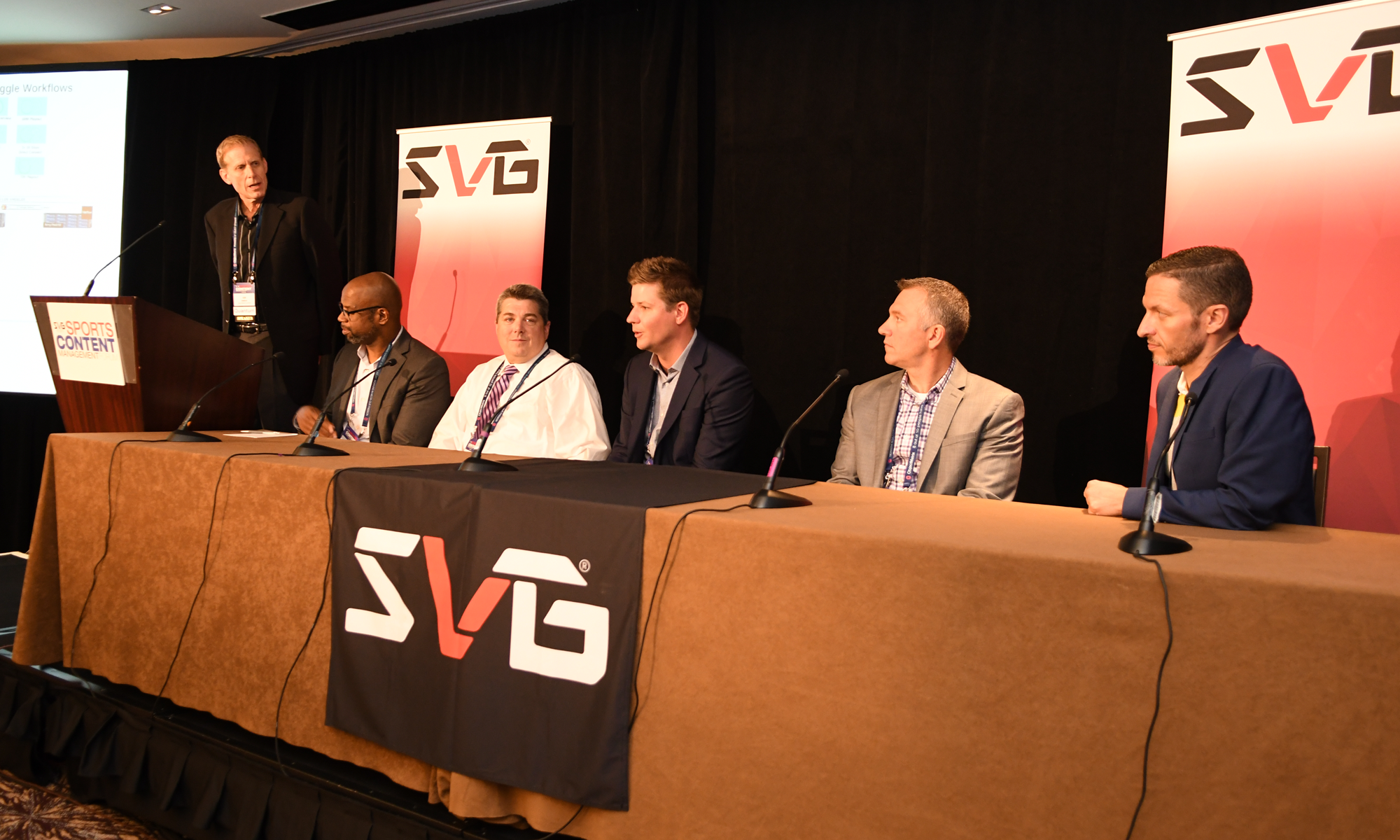Sports Content Management Forum: At-Home Workflows, Venue Connectivity Change the MAM Game
Execs from NBC Sports, Fox Sports, the NHL, WWE, and IBM Aspera dish on the latest trends in the business
Story Highlights
In this era of ultra-fractured media, with live events distributed across linear and digital properties and content shared at lightning speed across mobile networks and social platforms, a broadcast entity’s or sports league’s efforts to ingest, archive, share, grant proper access to, and apply metadata to highly valuable content are more complex than ever.

At the 2019 SVG Sports Content Management Forum, (from left) moderator Ken Adelson and panelists NBC Sports’ Darryl Jefferson, the NHL’s Grant Nodine, Fox Sports’ Brandon Potter, the WWE’s Bryan Staffaroni, and IBM Aspera’s James Wilson discoursed on the changing business of media-asset management.
However, the challenges offer massive opportunities for rightsholders, and, with the advance of various technologies, the business of managing content has reached an exciting apex.
Two key video-industry trends in particular have a significant impact on the world of MAM: the rise of at-home production workflows and the improvement of connectivity available in live-event venues.
Pushing the at-home production model the hardest are international mega events like the FIFA World Cup and the Olympic Games. These operations have hundreds of global rightsholders working with a central organization that serves as a world feed. It’s a logical place to push the envelope to both better leverage staff and cut costs.
“It makes more sense to keep a small army of producers and editors back home, if we can,” said Brandon Potter, director, post production, Fox Sports, at the 2019 SVG Sports Content Management Forum. “That presents many challenges in how you quickly [edit] 2 PB of content with that content 2,000 miles away.”
Fox Sports used similar workflows for its coverage of this summer’s FIFA Women’s World Cup in France and last year’s FIFA Men’s World Cup in Russia. The broadcaster, working alongside FIFA’s Host Broadcast Services, deployed a combination of technology from IBM Aspera, Telestream, and Levels Beyond’s Reach Engine to create proxies for video material, move them up to the cloud, and give its Los Angeles-based editors the ability to pull down selected clips without having to drag down an entire feed.
“The biggest challenge is obviously moving all of this content, but doing so securely,” said Potter. “We have this fortress that touches a bunch of other machines, but it’s not as simple as just throwing it up there. It was a big win for us to be able to do virus-scan on the fly as the content was uploaded.”
NBC Sports is in a similar (though much larger) position with its operation supporting the Olympic Games. With the Tokyo Olympics now less than a year away, NBC already has plans to keep even more of its staff at its home facility in Stamford, CT, to help meet the content-management needs of the Games.
“It’s the same challenge for us trying to leave as much as we can at home, and that’s not just for bottom line’s sake,” said Darryl Jefferson, VP, post operations and digital workflow, NBC Sports and Olympics, noting that, at the 2020 Tokyo Games, his servers and staff will have the additional load of new events — skateboarding, surfing, 3-on-3 basketball — and the return of baseball and softball. “We can actually offer more production value to more sports and be a wider organization if we do a lot more from home. I think pulling a lot of that content home will help us with the biggest business challenge, which is producing even more content with likely less people overall.”

At the 2019 SVG Sports Content Management Forum, NBC Sports’ Darryl Jefferson (left) discusses his company’s plans for the 2020 Tokyo Olympic Games as the NHL’s Grant Nodine looks on.
Now, all of these at-home production models are great, but none of these souped-up facilities at home are possible without strong, fast, and reliable connectivity in the venues where the sports events take place. New and renovated arenas across the U.S. have helped make content transport much quicker and more effective for broadcasters working within them, and that has made the difference in the eyes of Grant Nodine, SVP, technology, NHL.
“I think our architectures are all changing massively right now,” he said, adding that his league’s new facilities will be a SMPTE ST 2110 plant when the NHL moves its headquarters to Hudson Yards on Manhattan’s West Side during the upcoming season. “What we put in the venues is changing massively. I think what you’re going to see is a lot more mobile-native edge computing in the venues. 5G and CBRS wireless in the venues are going to flip the script for venues to manage how they deal with fans.
“You’re going from what’s essentially a fairly dumb Wi-Fi network,” he continued, “[which] you don’t get a lot of intelligence out of, to a network where you can all of a sudden know what bathroom every fan prefers from a given section. That’s a mundane detail and example, but, from a league perspective, you start to have opportunities to provide content to coaches, teams, and players in-game in a way that’s secure and has a guaranteed level of service. The way we are building things is changing.”
For leagues and governing bodies that don’t have the luxury of their own dedicated venues — such as the UFC, various boxing organizations, or the WWE — the variety of connectivity from arena to arena has long presented a daunting challenge, but, with increasingly advanced arenas, real-time content sharing becomes more possible.
“The goal has long been [having] all of the source material come back on the fly like a [satellite] return,” said Bryan Staffaroni, VP, media asset management, WWE. “I feel like we’re getting closer and closer to that because of the investment we are seeing in these arenas to give us that capability, speed, and bandwidth to get all of our content back to us as quickly as possible. Our production teams and our subscribers and fans are just waiting for the stuff to come to them. Whether it’s clips, snackable content, hidden gems, people want to see it first and share it once they see it and become social-media stars. That’s driving the need for content to come back sooner rather than later.”
Much of the innovation has been spurred, naturally, by the technology vendors. Organizations like IBM Aspera are constantly tasked with the challenge of helping major broadcasters and leagues better leverage the cloud and safely store and move large video files at lightning-fast speeds.
“It has been exciting for us to be central at a lot of these remote workflows,” said James Wilson, director, engineering, IBM Aspera. “At Aspera, we’re spending a lot of time thinking about how to template these types of workflows. There’s a lot of direct collaboration and integration with the end users and the vendors, who are driving these workflows to tune and establish what the future will look like. We also have smaller leagues like Formula E that are born and have existed only in the cloud.
“What we’re seeing more and more,” he continued, “is that Aspera and other vendors in the industry are just being composed together in these cloud-based and SaaS-based solutions. We’re looking at what does that evolution look like? Only about 20% of workflows today have been migrated to the cloud, so we have to be supporting hybrid deployment options.”
